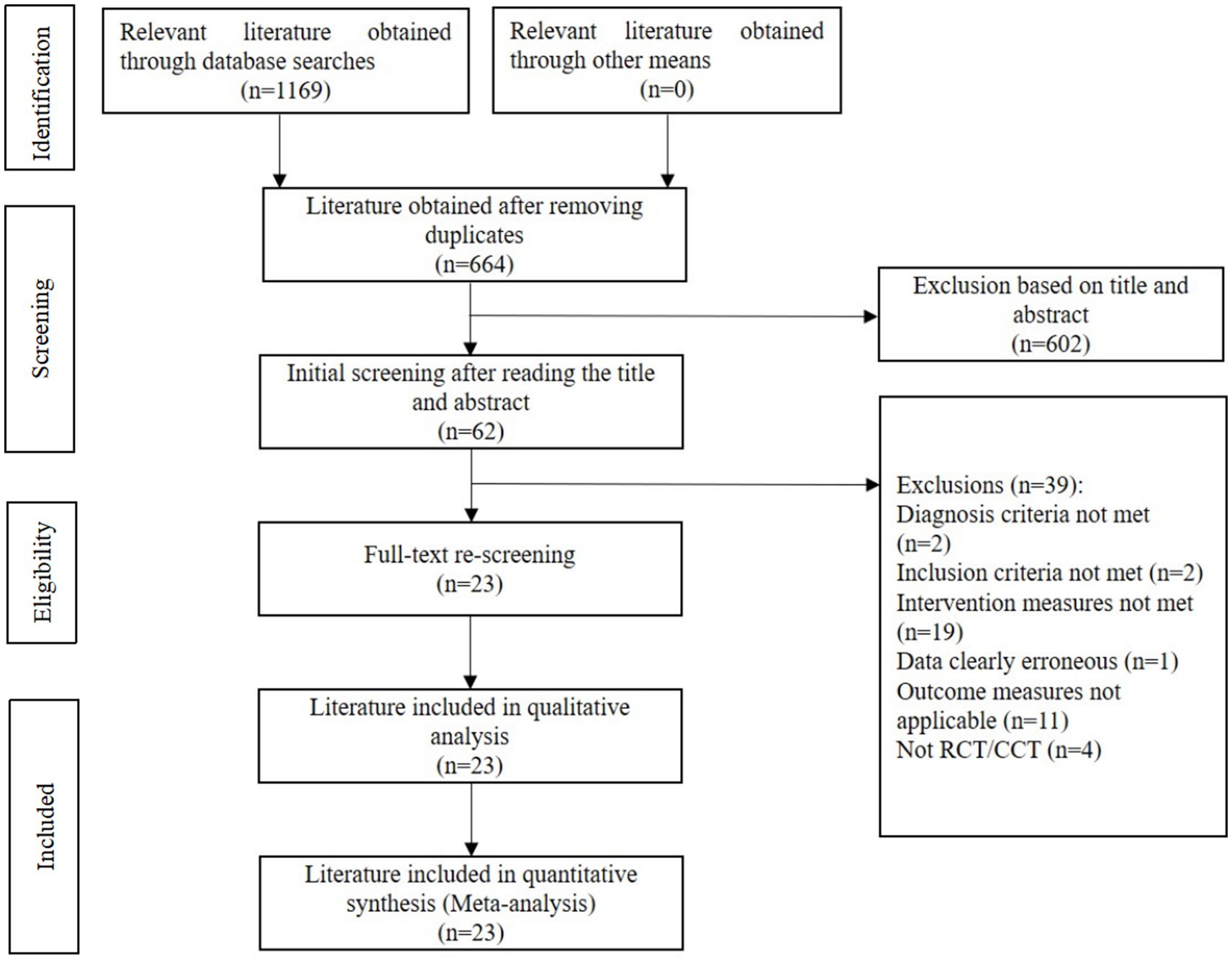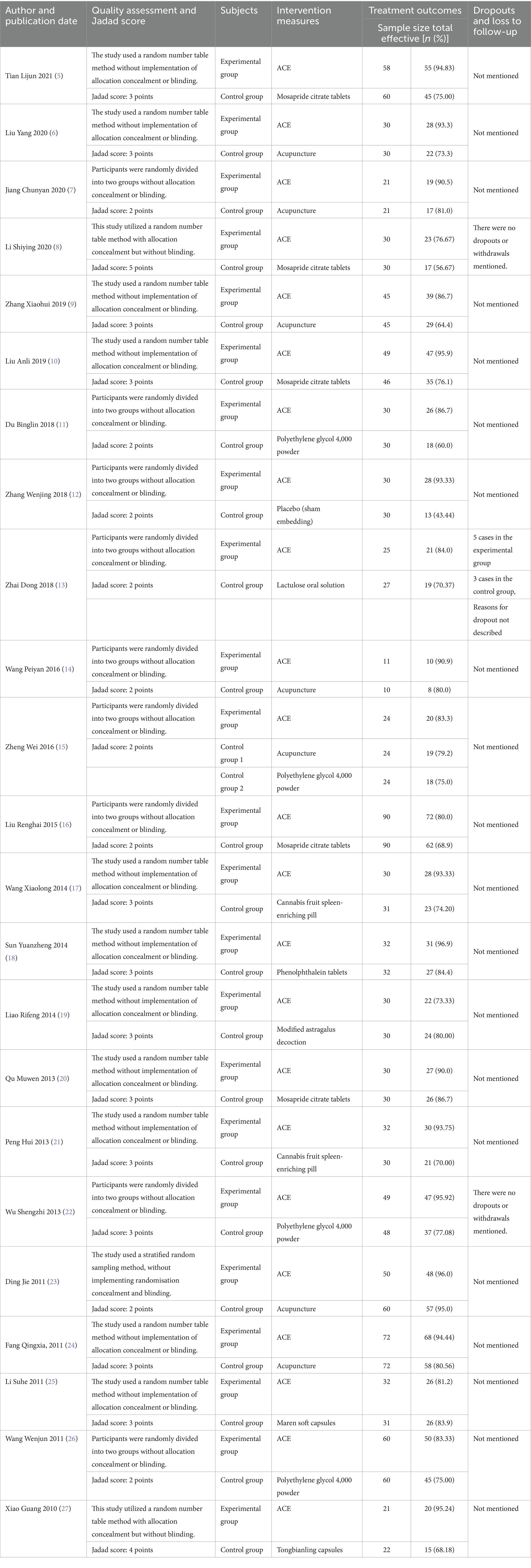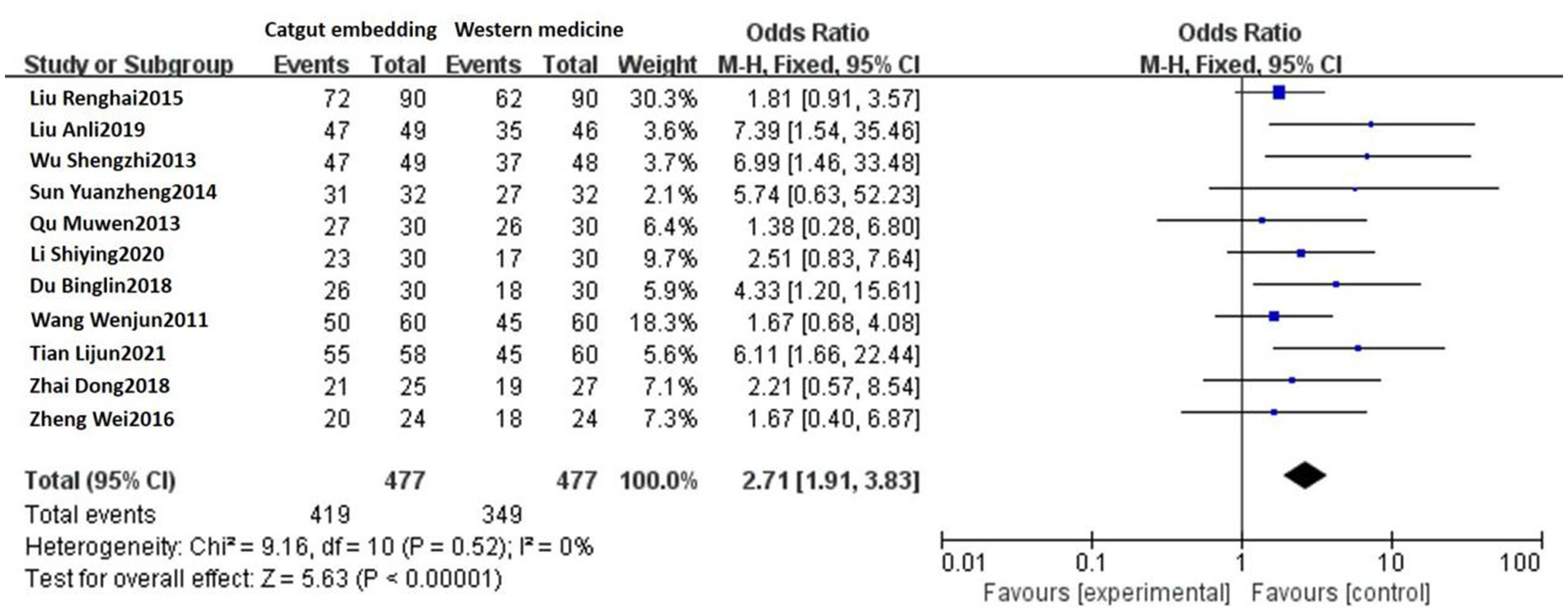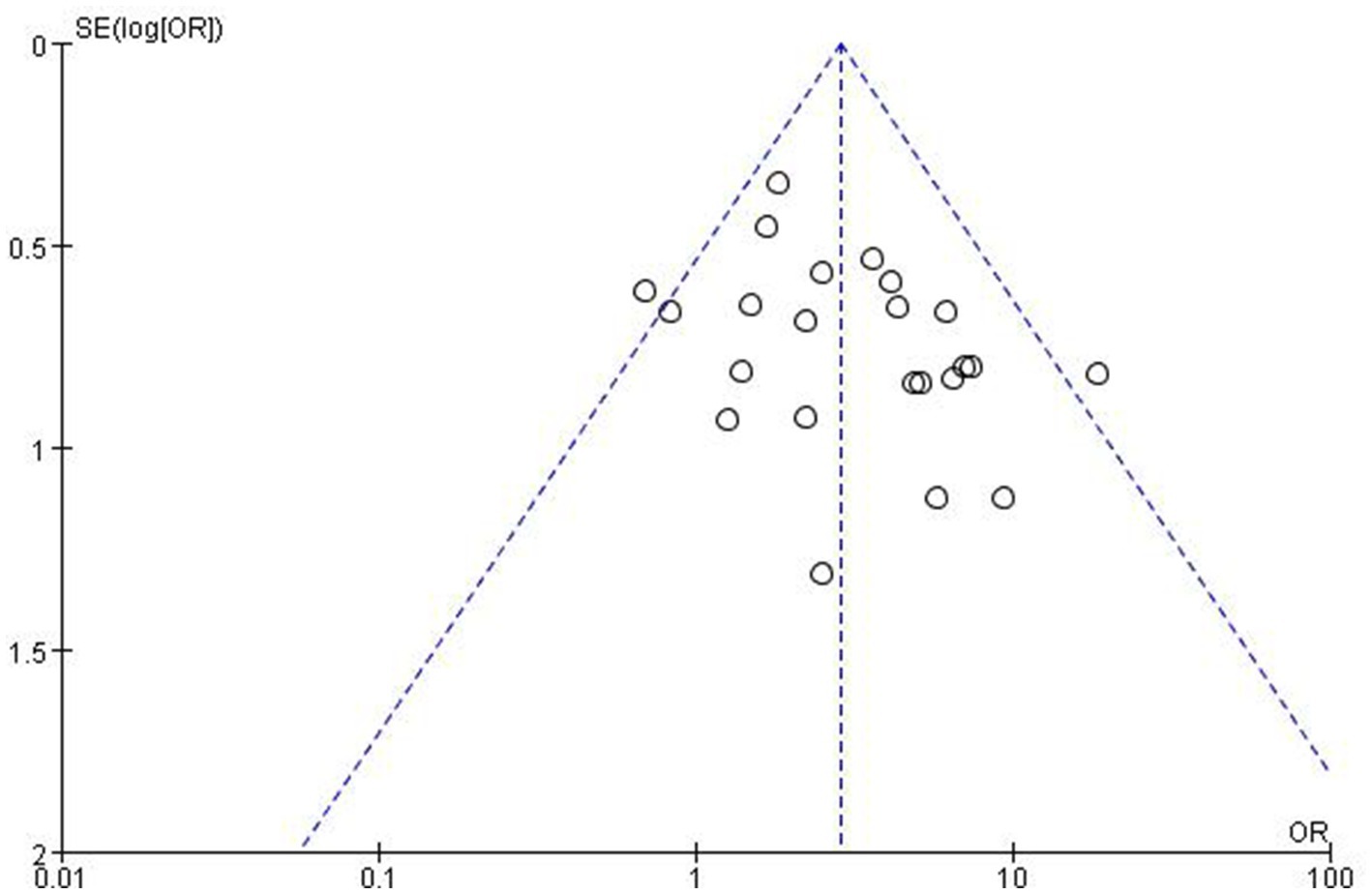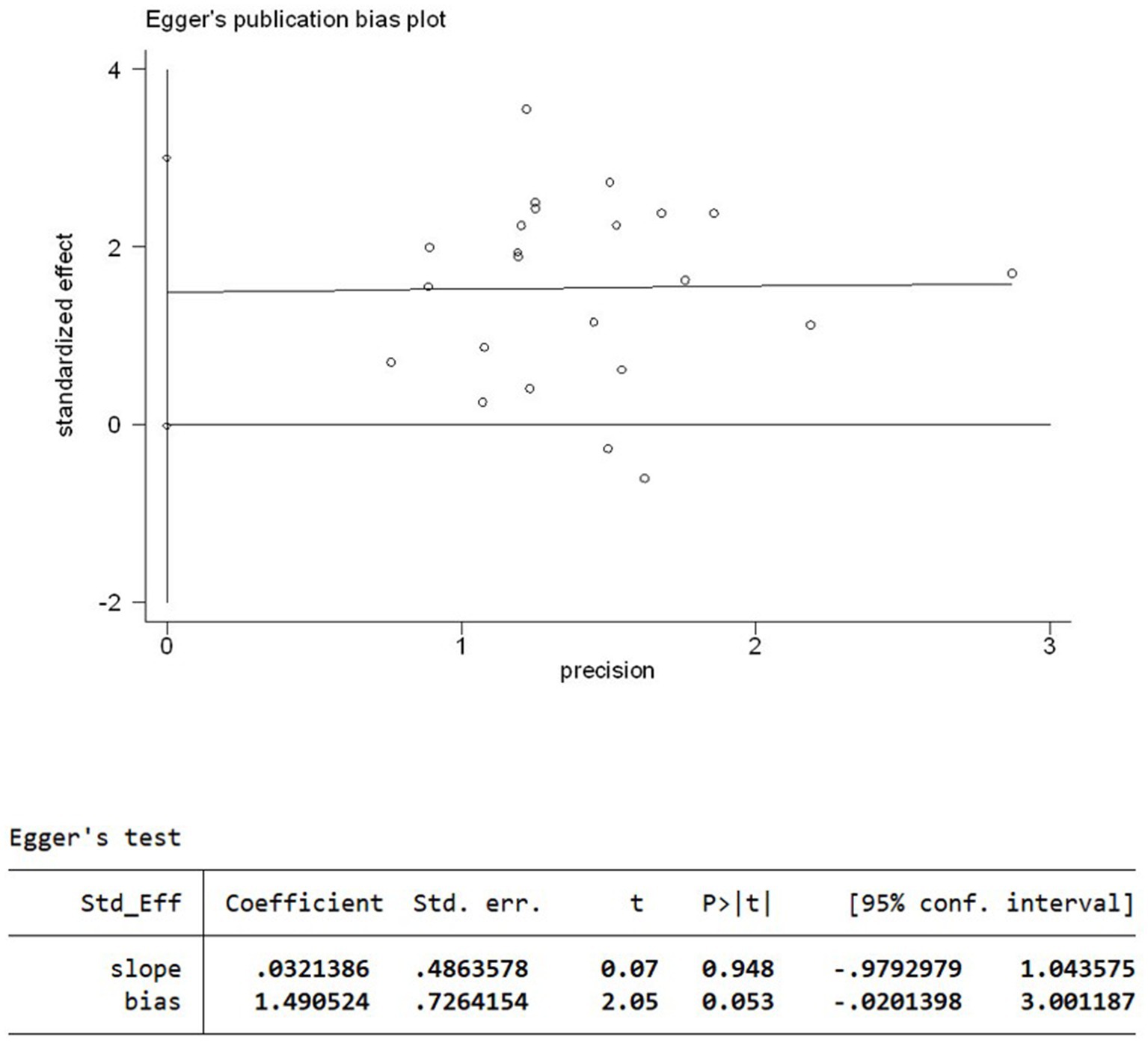- 1Department of Anorectal, Beijing University of Chinese Medicine, Beijing, China
- 2Department of Anorectal, Dongzhimen Hospital, Beijing University of Chinese Medicine, Beijing, China
Objective: To evaluate the efficacy and safety of acupoint embedding for FC by meta-analysis, in order to provide evidence-based medical evidence for clinical practice.
Methods: A comprehensive literature search was conducted in China National Knowledge Infrastructure, WanFang, VIP, PubMed, Web of Science and The Cochrane Library for randomised controlled trials (RCTs) on ACE for FC published from inception to November 2024. The included studies were assessed for quality using the modified Jadad scale, and statistical analysis was performed using RevMan 5.4.1 and Stata BE 17.
Results: A total of 23 studies involving 1,794 patients were included. The meta-analysis showed that the total effective rate of ACE was significantly higher compared with oral Western medicine (odds ratio [OR] = 2.71, 95% confidence interval [CI]: 1.91–3.83, p < 0.00001), acupuncture (OR = 2.90, 95% CI: 1.68–5.01, p = 0.0001) and placebo groups (p < 0.05). There was no significant difference between ACE and oral Chinese medicine (OR = 2.34, 95% CI: 0.79–6.89, p = 0.12). The incidence of adverse reactions in the ACE group was low, presenting mainly as mild local discomfort such as soreness, bruising and pain, which were self-limiting.
Conclusion: Acupoint catgut embedding demonstrates superior clinical efficacy compared with Western medicine, acupuncture and placebo in treating FC, with a low incidence of adverse effects. However, due to the limitations of the included studies, high-quality, large-sample RCTs are still needed to verify the long-term efficacy and safety of ACE.
Systematic review registration: Identifier INPLASY202570017.
1 Introduction
Functional constipation (FC) is a functional gastrointestinal disorder without identifiable organic lesions. Patients with FC may generally present with defecation difficulties, a decreased frequency of bowel movements and a sensation of incomplete evacuation. These symptoms significantly impair the quality of life for affected individuals (1). In addition to elevating the risk of developing colorectal polyps, constipation may also serve as one of the underlying triggers for cardio-cerebrovascular events.
According to an existing epidemiological study, the global prevalence of constipation ranges from approximately 3 to 21% (2). The rapid pace of life, coupled with rising life pressures and alterations in dietary patterns, has led to a year-on-year increase in the number of patients seeking medical treatment for FC in China. As such, FC has emerged as a significant public health concern (3).
In recent years, acupuncture, as a component of traditional Chinese medicine (TCM), has demonstrated distinct advantages in the treatment of functional gastrointestinal disorders, attributable to its holistic regulatory effects. Acupoint catgut embedding (ACE), a significant branch of acupuncture, has gained widespread application in the treatment of FC. This method is favoured for its simple operation, lasting efficacy and high patient compliance. Acupoint catgut embedding has been documented in clinical studies to have certain therapeutic effects on FC symptoms. However, there is still insufficient evidence-based medical proof of its efficacy. Moreover, there is a notable absence of high-quality systematic reviews on this topic.
Accordingly, on the basis of a systematic review and meta-analysis of randomised controlled trials (RCTs) published up to November 2024, this study aims to evaluate the efficacy and safety of acupoint embedding for FC by meta-analysis, in order to provide evidence-based medical evidence for clinical practice.
2 Data and methods
2.1 Types of literature
2.1.1 Types of research
This study was conducted based on the inclusion of RCTs and controlled clinical trials (CCTs) from both domestic and international sources. PRISMA guidelines were followed for this study. The registration number is INPLASY202570017.
2.1.2 Inclusion criteria
To be included in the meta-analysis, studies had to meet the following criteria:
(1) Publication date: RCTs or CCTs on ACE for FC published from inception to November 2024.
(2) Participants: patients clearly diagnosed with FC [met Rome (II, III, IV) diagnostic criteria for FC (4)], irrespective of gender or age.
(3) Interventions: The experimental group received ACE as a primary intervention, either alone or combined with other treatments.
(4) Control measures: The control group was provided with oral Western medicine, standard acupuncture, oral TCM or a placebo.
(5) Outcome measures: At a minimum, the total response rate must be reported (see Table 1). Additional efficacy evaluation indicators may include constipation severity scores using a constipation assessment scale (CAS), defecation frequency, stool consistency scores and quality of life scores using the Patient Assessment of Constipation Quality of Life (PAC-QOL) questionnaire.
2.1.3 Exclusion criteria
This study excluded literature that met any of the following criteria:
1. (1) Constipation caused by organic lesions (e.g., intestinal obstruction, inflammatory bowel disease and tumours).
2. (2) Patients with concurrent psychiatric disorders (e.g., severe anxiety and depression).
3. (3) Pregnant or lactating women.
4. (4) Acupoint catgut embedding was used only as a partial or temporary treatment, or was also used in the control group.
5. (5) Studies with incomplete data or studies from which valid data could not be extracted.
2.2 Literature retrieval strategy
A computer-based retrieval of eligible studies was conducted in the China National Knowledge Infrastructure (CNKI), WanFang Data, VIP, PubMed, Web of Science and Cochrane Library databases. The time for the retrieval was from the inception of databases until November 2024 (see Attachment 1).
Search terms:
• Chinese: Constipation, functional constipation, slow transit constipation, defecation disorder constipation, functional defecation disorder, catgut embedding at acupoints, randomised, randomised controlled.
• English: Constipation, functional constipation, slow transit constipation, defecation disorder constipation, functional defecation disorder, catgut embedding at acupoints, randomised, randomised controlled.
The retrieval strategy integrated free-text terms and Medical Subject Headings for refinement. Additionally, manual searches of reference lists from relevant articles were performed to identify any potentially overlooked studies.
Search methods: The first group of search terms included “catgut embedding” and “acupoint catgut embedding”, and each keyword was connected with “or” relationship. The second group of search terms included “constipation”, “functional constipation” and “slow transit constipation”, and each keyword was connected with “or” relationship. The third group of search terms included “random” and “randomised controlled”, and each keyword was connected with “or” relationship. The three groups of search terms were connected with “and” relationship, and the English search terms were searched with the same relationship at the same time.
2.3 Literature quality assessment
The methodological quality of each literature study included in the current research was evaluated using the modified Jadad scale:
• Studies with a score of 1–3 points were categorised as having poor quality.
• Studies with a score of 4–7 points were classified as having high quality.
The assessment covered aspects such as randomisation, allocation concealment, blinding, follow-up and dropout rates, ensuring the scientific rigour and reliability of the included literature.
2.4 Statistical methods
Data analysis was conducted using Review Manager (RevMan 5.4.1) and Stata BE 17 software for meta-analysis and plotting.
(1) Heterogeneity test: The Q test and I2 statistic were used to assess the heterogeneity between studies:
• The fixed-effect model was used when there was acceptable homogeneity (p ≥ 0.1 and I2 < 50%).
• Otherwise, the random-effect model was selected in case of heterogeneity (p < 0.1 and I2 ≥ 50%). Meanwhile, sensitivity analysis was conducted by sequentially omitting each study to identify the source of heterogeneity.
(2) Categorical data: The odds ratio (OR) was used to assess efficacy alongside the calculation of 95% confidence intervals (95% CI). A p ≤ 0.05 was considered statistically significant.
(3) Publication bias analysis: The possibility of publication bias was assessed using a funnel plot and Egger’s linear regression analysis. Any identified bias was adjusted using the trim and fill method.
3 Results
3.1 Literature retrieval results
A total of 1,169 relevant articles were retrieved in this study. Then, 505 duplicates were removed through literature management using EndNote. Based on the established inclusion and exclusion criteria, the titles and abstracts of the remaining articles were checked to exclude another 602 articles. Subsequent full-text reviews resulted in the final inclusion of 23 articles (published between 2010 and 2021) (5–27), involving 1,794 patients. The literature screening process is shown in Figure 1.
3.2 Basic characteristics of the included studies
A total of 23 articles were included, all of which were published in Chinese between 2010 and 2021. These articles involved 24 distinct groups (including the comparison of ACE with acupuncture and Western medicine separately by Zheng Wei et al. (15)), totalling 1,794 participants. Five studies were related to the comparison between an ACE group and a TCM group, involving 289 cases. Eleven studies conducted comparative analyses between an ACE group and a Western medicine group, with 954 cases. Meanwhile, another 7 studies (515 cases in total) compared an ACE group and an acupuncture group. Additionally, a comparison between an ACE group and a sham embedding (placebo) group was mentioned in 1 study with 60 cases.
3.3 Methodological quality rating of the included studies
Scoring results based on a modified Jadad scale are shown in Table 2. Among the 23 articles, 1 article scored 5 points, 1 scored 4 points, 12 scored 3 points, and 9 articles scored 2 points.
3.4 Meta-analysis of clinical efficacy
3.4.1 Comparison between the acupoint catgut embedding group and the traditional Chinese medicine group
Five studies reported the response rates of ACE vs. TCM. Heterogeneity was detected among these studies (p = 0.04, I2 = 59%). Sensitivity analysis indicated that the high heterogeneity was due to the negative results reported in the study by Liao Rifeng et al. (19), which was not excluded after a thorough reading. Using a random-effects model, the results showed that the response rate was 86.90% (126/145) in the ACE group and 75.69% (109/144) in the TCM group. As shown in Figure 2, there was no statistically significant difference between the two groups [OR = 2.34, 95% CI: 0.79, 6.89, Z = 1.54, p = 0.12].
3.4.2 Comparison between the acupoint catgut embedding group and Western medicine group
Eleven studies reported the response rates of ACE vs. Western medicine. No heterogeneity was detected among these studies (p = 0.52, I2 = 0%), and a fixed-effects model was used. The results showed that the response rates were 87.84% (419/477) and 73.17% (349/477) in the ACE group and the Western medicine group, respectively. There was a statistically significant difference between the two groups [OR = 2.71, 95% CI: 1.91, 3.83, Z = 5.63, p < 0.00001; see Figure 3].
3.4.3 Comparison between the acupoint catgut embedding group and the acupuncture group
Seven studies reported the response rates of ACE vs. acupuncture. A fixed-effect model was used, considering that no heterogeneity was detected among these studies (p = 0.81, I2 = 0%). The response rate of the ACE group was 91.70% (232/253) and 80.15% (210/262) in the acupuncture group. There was a statistically significant difference between the two groups [OR = 2.90, 95% CI: 1.68, 5.01, Z = 3.81, p = 0.0001; see Figure 4].
3.4.4 Comparison between the acupoint catgut embedding group and a sham embedding (placebo) group
One study reported the response rates of ACE and sham embedding. The response rate of ACE was 93.33% (28/30), while that of sham embedding was 43.33% (13/30). The response rate of ACE was higher compared with sham embedding, and the difference was significant (Z = 3.55, p = 0.0004).
3.5 Bias analysis
A funnel plot (Figure 5) of response rates was drawn with the OR on the X-axis and standard error on the Y-axis, and the scatter plot was essentially symmetrical. No significant publication bias was observed according to the results of Egger’s linear regression as shown in Figure 6 (p = 0.053 > 0.05).
3.6 Adverse reactions
Among the 23 articles reviewed, 7 articles specifically documented adverse reactions, which were observed in 5 cases among 296 patients in the experimental group. The reported adverse reactions included localised soreness, swelling, bruising and pain at the site of the catgut embedding. All of these symptoms were effectively alleviated following the application of a local hot compress.
4 Discussion
Functional constipation falls into the category of “constipation” in TCM and is characterised by an ease of diagnosis but difficulty in treatment, with its pathophysiological mechanisms not yet fully elucidated. In modern medicine, FC is commonly treated by pharmacological agents, including laxatives, prokinetic agents and microbiological preparations, as well as interventions such as enemas and surgical procedures. Nevertheless, these methods exhibit certain limitations concerning their long-term efficacy and safety (28). The prolonged use of stimulant laxatives, including anthraquinone drugs, aloe, senna leaves and rhubarb, may be associated with an elevated risk of melanosis coli and colon polyps (29). Against this background, a strong focus has been attached to the benefits of ACE therapy, grounded in TCM theory, in the treatment of constipation. At present, ACE therapy for constipation presents a mature clinical system in Asia, especially in China, and is also widely used in South Korea and Japan. However, its popularity is lower in China, and it is a niche therapy in Europe and the United States, where it is still in the research and exploration stage.
According to Miraculous Pivot: End and Beginning, “For chronic diseases, where pathogenic factors have penetrated deeply, needles should be inserted deeply and retained for longer periods”. This emphasises that for chronic conditions, acupuncture must reach deep into the affected area and provide sustained action. Acupoint catgut embedding has been developed in accordance with this theoretical framework (30). The treatment is the product of combining acupuncture and moxibustion theory, Chinese materia medica and modern physics. Under the guidance of acupuncture and the moxibustion meridian system, catgut or other absorbable sutures are placed in the corresponding acupoint area. Following a soft, slow, long-term and benign acupoint acupuncture stimulation effect, it achieves the effect of dredging the meridians, qi and blood, and is able to prevent and treat diseases (30). It is a compound treatment method that combines multiple therapies and multiple effects. From the perspective of TCM, the acupoints for catgut embedding (e.g., Tianshu, Dachangshu, and Zusanli) can invigorate the spleen and qi, promote the transport of the spleen and stomach and restore intestinal conduction function. Catgut embedding can also stimulate dredging of the meridians and promote the patency of qi and blood (31). From a Western medicine perspective, the embedded suture-body serves as a form of minor foreign body stimulation at acupoints, continuously excites local nerves (e.g., the intestinal plexus), promotes intestinal smooth muscle contraction and accelerates defecation (32). In addition, ACE has been found to improve serum brain–gut peptide levels in patients with slow transit constipation (33), reduce neuronal apoptosis and, subsequently, relieve constipation symptoms (34). Compared to traditional acupuncture, catgut utilised in ACE is typically fully absorbed within a period of 14 to 21 days. Throughout this duration, it provides continuous stimulation to the acupoints, thereby reducing the frequency of medical visits to some extent and enhancing patient compliance with treatment (35). Acupoint catgut embedding has gained widespread application in clinical practice due to its prolonged stimulation, user-friendly operation and lasting therapeutic effects. Based on the included literature, this study concludes that the commonly used acupoints of ACE for the treatment of constipation include Guanyuan, Zusanli and Dachangshu, which regulate intestinal function, increase the frequency of defecation and improve the condition of faeces by stimulating these acupoints. Xue Qiming et al. (36) performed ACE at the Tianshu and Abdominal Jie points, and the results showed that the weekly average complete defecation frequency increased in the catgut embedding group after treatment, and the PAC-QOL quality of life score was lower after catgut embedding treatment than in the control group, indicating that ACE could achieve the effect of regulating large intestine fu-qi. In a study conducted by Yin Ping (37), catgut embedding was performed at the Shangjuxu, Tianshu, Zusanli, Shuidao and Dachangshu points, and the overall response rate was 83.3% after treatment. The symptom checklist PAC-SYM, PAC-QOL and straining during defecation and abdominal distension scores were significantly improved.
In the present meta-analysis, ACE showed significant clinical efficacy in the treatment of FC. The overall response rate was markedly superior to that of oral Western medicine, standard acupuncture and placebo (sham embedding) treatments, and its efficacy was comparable to that of oral TCM. Furthermore, there was a relatively low incidence of adverse reactions associated with ACE, primarily presenting as localised soreness, swelling, bruising and mild pain when present. These symptoms can typically be mitigated through the application of a local hot compress. Notably, there were no documented cases of severe adverse events, suggesting a favourable safety profile for this therapy. There are, however, some caveats to remember when performing ACE therapy. First, to avoid infection, following catgut embedding at acupoints, the embedding site should not be contaminated with water, but complexed iodine can be used to disinfect the local area and keep it clean. Hot weather easy to sweat, at this time the catgut embedding time should not be too long to prevent infection. Second, the patient should be mindful of staying warm because once catgut embedding at acupoints has taken place, the embedding site will have subtle pinholes; cold stimulation should be avoided to not cause a decreased body resistance, which may affect the effect of catgut embedding at acupoints. Finally, diet should be monitored; spicy food such as seafood and too much pepper should be avoided, as well as alcohol consumption, to avoid stimulating the skin and causing itchiness and other adverse reactions. In addition, ACE has some contraindications, including coagulation dysfunction combined with infection, bleeding; local skin infection; combined with severe heart, liver and kidney dysfunction or critical illness cannot use this method.
This study is not without its limitations. First, the quality of the studies included in this research was predominantly subpar. The results of the Jadad scale indicated that only 2 of the 23 articles could be classified as high-quality studies. Furthermore, 10 articles failed to clearly delineate their randomisation methods, and only 2 employed concealed randomisation. The majority of the studies did not utilise a double-blind design; this means that the researchers were not blinded to observers, which may have resulted in both selection and observation biases. Second, the final articles incorporated in this study were exclusively domestic, which may have introduced publication bias and potentially compromised the external validity of the results. Third, differences in the baseline characteristics of patients, criteria for efficacy evaluation and variations in ACE techniques (e.g., the selection of points and depth of embedding) contributed to low homogeneity among the studies. Furthermore, the inherent specificity of ACE posed challenges in terms of fully establishing double-blind conditions, which may have compromised the reliability of the results. Consequently, the outcomes of this study have limited reference value. Additional high-quality RCTs with large sample sizes are necessary to validate the clinical efficacy and long-term safety of ACE for FC.
5 Conclusion
This study, which is grounded in a meta-analysis, demonstrates that ACE exhibits significant clinical efficacy in the treatment of FC. The efficacy of this method surpasses that of oral Western medicine, standard acupuncture and placebo treatments. Furthermore, it is associated with mild adverse reactions and a high safety profile. The potential mechanisms of action may include the regulation of meridians, modulation of the neuroendocrine axis, and the enhancement of gastrointestinal motility. Future high-quality RCTs are required for further validation to facilitate the clinical dissemination and application of this therapy.
Data availability statement
The original contributions presented in the study are included in the article/Supplementary material, further inquiries can be directed to the corresponding author.
Author contributions
YZ: Conceptualization, Formal analysis, Supervision, Writing – original draft, Writing – review & editing. ZW: Data curation, Investigation, Writing – review & editing. SK: Data curation, Investigation, Writing – review & editing. SZ: Data curation, Investigation, Writing – review & editing.
Funding
The author(s) declare that financial support was received for the research and/or publication of this article. This work was supported by Beijing Natural Science Foundation General Project (7242237).
Conflict of interest
The authors declare that the research was conducted in the absence of any commercial or financial relationships that could be construed as a potential conflict of interest.
Generative AI statement
The authors declare that no Gen AI was used in the creation of this manuscript.
Any alternative text (alt text) provided alongside figures in this article has been generated by Frontiers with the support of artificial intelligence and reasonable efforts have been made to ensure accuracy, including review by the authors wherever possible. If you identify any issues, please contact us.
Publisher’s note
All claims expressed in this article are solely those of the authors and do not necessarily represent those of their affiliated organizations, or those of the publisher, the editors and the reviewers. Any product that may be evaluated in this article, or claim that may be made by its manufacturer, is not guaranteed or endorsed by the publisher.
Supplementary material
The Supplementary material for this article can be found online at: https://www.frontiersin.org/articles/10.3389/fmed.2025.1592220/full#supplementary-material
References
1. Kilgore, A, and Khlevner, J. Functional constipation: pathophysiology, evaluation, and management. Aliment Pharmacol Ther. (2024) 60:S20–9. doi: 10.1111/apt.17852
2. Matsumoto, M, Yoshida, M, Miura, Y, Sato, N, Okawa, Y, Yamada, M, et al. Feasibility of the constipation point-of-care ultrasound educational program in observing fecal retention in the colorectum: a descriptive study. Jpn J Nurs Sci. (2021) 18:e12385. doi: 10.1111/jjns.12385
3. Gong, L, Du, H, Guo, X, Li, J, Zhu, X, Shen, X, et al. Shouhui Tongbian capsule in treatment of constipation: treatment and mechanism development. Chin Herb Med. (2023) 16:239–47. doi: 10.1016/j.chmed.2023.05.006
4. Drossman, DA. Functional gastrointestinal disorders: history, pathophysiology, clinical features and Rome IV. Gastroenterology. (2016) 150:1262–79. doi: 10.1053/j.gastro.2016.02.032
5. Tian, LJ, Guan, W, and Long, ZJ. Evaluation of clinical efficacy of large intestine acupoint embedding for slow transit constipation. Liaoning J Tradit Chin Med. (2021) 48:155–8. doi: 10.13192/j.issn.1000-1719.2021.03.044
6. Liu, Y, Zhou, PF, Jiang, YX, Jiang, N, Liu, X, and Liu, DW. On the efficacy of acupoint catgut embedding therapy for functional constipation. Shanghai J Acupunct Moxibustion. (2020) 39:1362–5. doi: 10.13460/j.issn.1005-0957.2020.13.1073
7. Jiang, CY, Li, CG, Sheng, DD, and Tan, YJ. An observation of the therapeutic effects of simple acupoint catgut embedding therapy for qi deficiency type habitual constipation. Zhejiang J Tradit Chin Med. (2020) 55:364. doi: 10.13633/j.cnki.zjtcm.2020.05.035
8. Li, S. On the Treatment of Spleen and Kidney Yang Deficiency Type Slow Transit Constipation with Acupuncture with Acupoint Catgut Embedding. Beijing: Beijing University of Chinese Medicine (2020).
9. Zhang, XH, Xue, QM, Yong, FJ, Song, DL, and Wen, J. Clinical efficacy evaluation of acupoint catgut embedding therapy for functional constipation. J Sichuan Tradit Chin Med. (2019) 37:219–21.
10. Liu, AL. Observation on the efficacy of acupoint catgut embedding therapy for slow transit constipation. Shanghai J Acupunct. (2019) 38:505–9. doi: 10.13460/j.issn.1005-0957.2019.05.0505
11. Du, BL, and Xu, ZM. Clinical study on acupoint catgut embedding therapy for qi deficiency type constipation. Chin Community Doctors. (2018) 34:80–1. doi: 10.3969/j.issn.1007-614x.2018.12.049
12. Zhang, WJ, and Ren, YY. Clinical observation of 30 cases of functional constipation in middle-aged and elderly patients with spleen and kidney Yang deficiency type treated by Acupoint catgut embedding therapy. Yunnan J Tradit Chin Med Mater Med. (2018) 39:56–8. doi: 10.3969/j.issn.1007-2349.2018.06.025
13. Zhai, D, Tong, XJ, Wang, C, and Shi, BL. A randomized controlled study on the treatment of functional constipation in the elderly using acupuncture at the Baliao acupoint. Chin J Integr Tradit West Med Dig. (2018) 26:751–5. doi: 10.3969/j.issn.1671-038X.2018.09.09
14. Wang, PY. On the efficacy of acupoint catgut embedding therapy for habitual constipation. J Pract Tradit Chin Med. (2016) 32:1114. doi: 10.3969/j.issn.1004-2814.2016.11.057
15. Zheng, W. Clinical observation of acupoint catgut embedding therapy for chronic functional constipation (yin deficiency and intestinal dryness type). Inner Mongolia J Tradit Chin Med. (2016) 35:100. doi: 10.3969/j.issn.1006-0979.2016.09.096
16. Liu, RH, Yuan, L, Zhang, SL, and Lu, XY. An observational study on the therapeutic effects of the acupoint catgut embedding method in 90 cases of slow transit constipation characterized by spleen deficiency and qi stagnation. J Beijing Univ Tradit Chin Med. (2015) 34:380–2. doi: 10.16025/j.1674-1307.2015.05.013
17. Wang, XL, and Zhou, ZY. An observation of the therapeutic effects of acupoint catgut embedding therapy in 30 cases of slow transit constipation. J Gansu Univ Tradit Chin Med. (2014) 31:60–2.
18. Sun, YZ, Guo, Q, and Zhu, PY. Observation on the efficacy of Yumu acupoint catgut embedding therapy for senile constipation. Shanghai J Acupunct Moxibustion. (2014) 33:222–3. doi: 10.13460/j.issn.1005-0957.2014.03.0222
19. Liao, RF. Clinical study on acupoint catgut embedding therapy for functional constipation of lung and spleen qi deficiency type. Guangzhou: Guangzhou University of Chinese Medicine (2014).
20. Qu, MW, Li, GD, Hong, ZF, Zhi, JW, He, YH, Jing, JZ, et al. Clinical observation of 30 cases of slow transit constipation treated with acupoint catgut embedding therapy at the Baliao acupoint. J Tradit Chin Med. (2013) 54:1663–5. doi: 10.13288/j.11-2166/r.2013.19.014
21. Peng, H, and Liu, JP. Acupoint catgut embedding therapy for 32 cases of slow transit constipation. Mod Tradit Chin Med. (2013) 33:54–55, 65. doi: 10.13424/j.cnki.mtcm.2013.01.017
22. Wu, SZ, Zheng, WF, Lu, ZH, and Hu, PL Treatment of Functional Slow Transit Constipation Using Acupoint Catgut Embedding. Annual Academic Meeting of the Colorectal Surgery Branch of the Zhejiang Medical Association, Colorectal Diseases Branch of the Zhejiang Province Association of Traditional Chinese Medicine, and Colorectal Surgeons Branch of the Zhejiang Medical Doctors Association. Proceedings of the 2013 Zhejiang Provincial Colorectal Surgery Academic Annual Meeting and Advanced Learning Workshop on Minimally Invasive and Comprehensive Treatments for Colorectal Diseases. Zhejiang: Colorectal Surgery Branch of the Zhejiang Medical Association, Colorectal Diseases Branch of the Zhejiang Province Association of Traditional Chinese Medicine, Colorectal Surgeons Branch of the Zhejiang Medical Doctors Association: Zhejiang Association for Science and Technology, (2013): 2.
23. Ding, J, and Liu, SJ. Clinical observation of acupoint catgut embedding therapy in 50 cases of slow transit constipation. J Liaoning Univ Tradit Chin Med. (2011) 13:218–9. doi: 10.13194/j.jlunivtcm.2011.05.220.dingj.064
24. Fang, QX, Wang, SS, and Xie, YL. Clinical observation of 72 patients with functional constipation treated by acupoint catgut embedding therapy. J Tradit Chin Med. (2011) 52:1849–51. doi: 10.13288/j.11-2166/r.2011.21.012
25. Li, SH, and Gu, YZ (2011). Clinical study on 32 cases of functional constipation treated by acupoint catgut implantation. Proceedings of the 2011 Annual Meeting of the China Association of Acupuncture-Moxibustion. Beijing: China Association of Acupuncture-Moxibustion. 198–202.
26. Wang, WJ. Clinical Study on The Treatment of Spleen Deficiency and Qi Stagnation Type Slow Transit Constipation Using Acupoint Catgut Embedding Therapy. Beijing: Beijing University of Chinese Medicine (2011).
27. Xiao, G. (2010). Clinical Study on Acupoint Catgut Embedding Therapy For Slow Transit Constipation. Liaoning: Liaoning University of Traditional Chinese Medicine.
28. Paknejad, MS, Motaharifard, MS, Barimani, S, Kabiri, P, and Karimi, M. Traditional, complementary and alternative medicine in children constipation: a systematic review. Daru. (2019) 27:811–26. doi: 10.1007/s40199-019-00297-w. Epub 2019 Nov 16
29. Rao, SSC, and Brenner, DM. Efficacy and safety of over-the-counter therapies for chronic constipation: An updated systematic review. Am J Gastroenterol. (2021) 116:1156–81. doi: 10.14309/ajg.0000000000001222
30. Barbara, G, Barbaro, MR, Marasco, G, and Cremon, C. Chronic constipation: from pathophysiology to management. Minerva Gastroenterol (Torino). (2023) 69:277–90. doi: 10.23736/S2724-5985.22.03335-6
31. Yan, J, Hu, X, Tang, HT, and Li, J. Theoretical analysis of Shangjuxu treatment theory. J Clin Acupunct Moxibustion. (2021) 37:94–7. doi: 10.19917/j.cnki.1005-0779.021232
32. Zhang, Q, and Zhao, YP. Effect of catgut embedding therapy at acupoint on colonic transit function, plasma substance P and vasoactive intestinal peptide in slow transit constipation. Mod J Integr Tradit Chin West Med. (2021) 30:763–6. doi: 10.3969/j.issn.1008-8849.2021.07.019
33. Cao, QR, and Li, LY. Clinical efficacy of catgut embedding at acupoint in the treatment of elderly patients with functional constipation and its effect on serum intestinal neurotransmitter levels. J Shanxi Univ Chin Med. (2021) 22:434–7. doi: 10.19763/j.cnki.2096-7403.2021.06.11
34. Xie, ZN, An, XJ, Yang, B, Li, DB, Wang, FL, Miao, CH, et al. Regulation of acupoint intensive catgut embedding therapy on ICC and neuronal cells in rectal tissue of STC patients. World Chin Med. (2020) 15:2973–7. doi: 10.3969/j.issn.1673-7202.2020.19.025
35. Hojo, M, Shibuya, T, and Nagahara, A. Management of Chronic Constipation: a comprehensive review. Intern Med. (2025) 64:7–15. doi: 10.2169/internalmedicine.2867-23
36. Xue, QM, Yong, FJ, Song, DL, and Zhang, XH. Effect of catgut embedding at acupoints on spontaneous defecation frequency and quality of life in patients with functional constipation. Shanghai J Acupunct Moxibustion. (2020) 39:702–5. doi: 10.13460/j.issn.1005-0957.2020.06.0702
Keywords: acupoint catgut embedding, functional constipation, meta-analysis, randomised controlled trial, evidence-based medicine
Citation: Zhao Y, Wang Z, Kuang S and Zhang S (2025) A meta analysis of the acupoint catgut embedding in the treatment of functional constipation. Front. Med. 12:1592220. doi: 10.3389/fmed.2025.1592220
Edited by:
I-Shiang Tzeng, National Taipei University, TaiwanReviewed by:
Nilton Carlos Machado, São Paulo State University, BrazilBing Yan, China Academy of Chinese Medical Sciences, China
Weiye Zhang, University of California, San Francisco, United States
Copyright © 2025 Zhao, Wang, Kuang and Zhang. This is an open-access article distributed under the terms of the Creative Commons Attribution License (CC BY). The use, distribution or reproduction in other forums is permitted, provided the original author(s) and the copyright owner(s) are credited and that the original publication in this journal is cited, in accordance with accepted academic practice. No use, distribution or reproduction is permitted which does not comply with these terms.
*Correspondence: Shuxin Zhang, emhhbmdzaHV4aW5fc2h4eEAxMjYuY29t
 Yufei Zhao1
Yufei Zhao1 Shuxin Zhang
Shuxin Zhang
